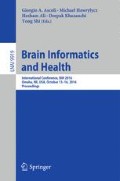Abstract
Emotion is considered as a critical aspect of human brain behavior. In this paper, we investigate human normal emotion variation for a long period without stimuli. Eight subjects participated in the experiment for seven days. The EEG signal and POMS scale of the subjects were collected in the experiment. After data collection and preprocessing, Pearson correlation analysis and multiple linear regression analysis were carried out between EEG features and POMS emotion components. The results of Pearson correlation analysis show that the correlation coefficient of EEG features and POMS emotion component range from 0.367 to 0.610 at 0.01 significant levels. Based on this, multiple linear regression models are built between POMS emotion components and EEG features. With these models, the POMS scales of the subjects can be predicted such that the R2 between the prediction scale and real scale ranges from 0.329 to 0.772; the emotion of ‘Depression-Dejection’ has the lowest R2 (0.329); and the ‘Negative Emotion’ has the highest R2 (0.772).
Access this chapter
Tax calculation will be finalised at checkout
Purchases are for personal use only
References
Cabanac, M.: What is emotion? Behav. Process. 60(2), 69–83 (2002)
Schacter, D.L.: Psychology, 2nd edn. Worth Publishers, New York (2011). p. 310. ISBN 978-1-4292-3719-2
MULTI-HEALTH SYSTEMS. http://www.mhs.com/
Zhu, B.: Brief introduction of POMS scale and its model for China. J. Tianjin Inst. Phys. Educ. 10(1), 35–37 (1995)
Su, Y., Hu, B., Xu, L., Cai, H., Moore, P., Zhang, X., Chen, J.: EmotionO+: physiological signals knowledge representation and emotion reasoning model for mental health monitoring. In: Proceedings of 2014 IEEE International Conference on Bioinformatics and Biomedicine (BIBM 2014), pp. 529–535 (2014)
Wang, D., Miao, D., Xie, C.: Best basis-based wavelet packet entropy feature extraction and hierarchical EEG classification for epileptic detection. Expert Syst. Appl. 38(11), 14314–14320 (2011)
DEAP data set online web index. http://www.eecs.qmul.ac.uk/mmv/datasets/deap/
Chen, J., Hu, B., Moore, P., Zhang, X., Ma, X.: Electroencephalogram-based emotion assessment system using ontology and data mining techniques. Appl. Soft Comput. 30, 663–674 (2015)
Muhl, C., Soleymani, M., Lee, J.S., Yazdani, A., Ebrahimi, T., Pun, T., Nijholt, A., Patras, I.: DEAP: a database for emotion analysis using physiological signal. IEEE Trans. Affect. Comput. 3(1), 18–31 (2012)
Chanel, G., Kierkels, J.J.M., Soleymani, M., Pun, T.: Short-term emotion assessment in a recall paradigm. Int. J. Hum. Comput. Stud. 67, 607–627 (2009)
Acharya, R., Faust, U.O., Kannathal, N., Chua, T., Laxminarayan, S.: Non-linear analysis of EEG signal at various sleep stages. Comput. Methods Programs Biomed. 80, 37–45 (2005)
Li, S., Zhou, W., Yuan, Q., Geng, S., Cai, D.: Feature extraction and recognition of ictal EEG using EMD and SVM. Comput. Biol. Med. 43(7), 807–816 (2013)
Khatwani, P., Tiwari, A.: A survey on different noise removal techniques of EEG signal. Int. J. Adv. Res. Comput. Commun. Eng. 2(2), 1091–1095 (2013)
Iacoviello, D., Petracca, A., Spezialetti, M., Placidi, G.: A real-time classification algorithm for EEG-based BCI driven by self-induced emotions. Comput. Methods Programs Biomed. 122(3), 293–303 (2015)
Tsuchiya, S., Morimoto, M., Imono, M., Watab, H.: Judging emotion from EEGs based on an association mechanism. Proc. Comput. Sci. 60, 37–44 (2015)
Acknowledgement
This work was partly supported by the National Basic Research Program of China under grant no. 2014CB744600, by the International Science & Technology Cooperation Program of China under grant no. 2013DFA32180, by the National Natural Science Foundation of China grant no. 61272345, by the Beijing Key Laboratory of Magnetic Resonance Imaging and Brain Informatics, and by the Beijing Municipal Commission of Education.
Author information
Authors and Affiliations
Corresponding author
Editor information
Editors and Affiliations
Rights and permissions
Copyright information
© 2016 Springer International Publishing AG
About this paper
Cite this paper
Li, Y. et al. (2016). Human Emotion Variation Analysis Based on EEG Signal and POMS Scale. In: Ascoli, G., Hawrylycz, M., Ali, H., Khazanchi, D., Shi, Y. (eds) Brain Informatics and Health. BIH 2016. Lecture Notes in Computer Science(), vol 9919. Springer, Cham. https://doi.org/10.1007/978-3-319-47103-7_8
Download citation
DOI: https://doi.org/10.1007/978-3-319-47103-7_8
Published:
Publisher Name: Springer, Cham
Print ISBN: 978-3-319-47102-0
Online ISBN: 978-3-319-47103-7
eBook Packages: Computer ScienceComputer Science (R0)

